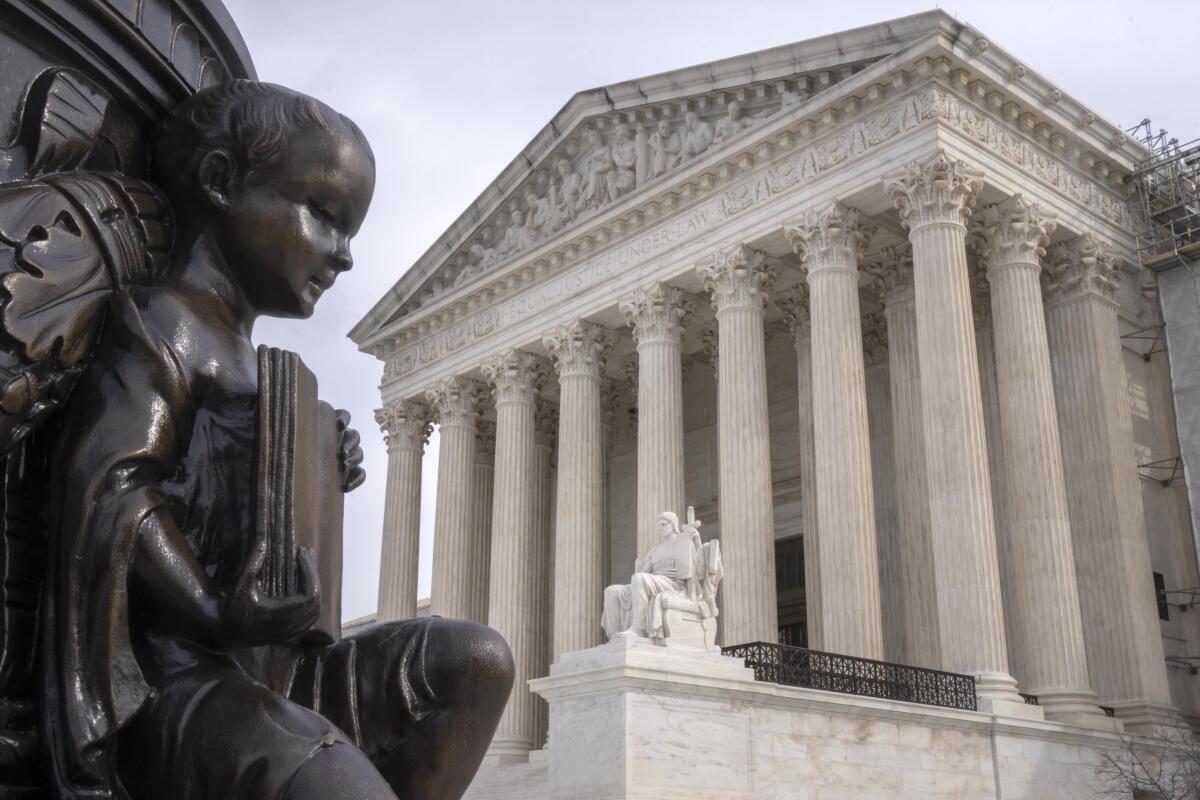Biden may endorse big Supreme Court reforms. Do term limits for justices have a chance?

- Share via
WASHINGTON — President Biden has told progressives in Congress that he will soon endorse proposals to reform the Supreme Court, including by putting term limits on the justices and enforcing an ethics code.
He also spoke in favor of a proposed constitutional amendment to overturn the immunity for presidents that the court’s conservative justices granted two weeks ago, according to media reports Wednesday.
But the president apparently remains opposed to expanding the court from nine to 13 justices.
If Democrats can win control of the House and Senate in the November election and Biden is reelected, some or all of these legislative proposals could move forward early next year. But polls suggest that outcome appears increasingly unlikely.
So for now, Biden’s proposed reforms remain largely political talking points for Democrats and progressives.
Nevertheless, court reform advocates welcomed Biden’s show of support.
“The court has long been the most powerful, least accountable part of our government, and you can’t ensure the long-term success of our democracy without implementing changes to our all-powerful and unaccountable juristocracy,” said Gabe Roth, executive director of Fix the Court, an advocacy group for court reform.
“The vast majority of the country, regardless of party, believes the justices should not serve for life, but ... should be subject to basic oversight like Congress and the executive [branch] are,” Roth said.
The idea of term limits has been popular with many Republicans over the last decade, and more recently with most Democrats as well.
Sean Eldridge, president of Stand Up America, a progressive advocacy group, pointed to a national poll in March in which 64% of voters surveyed supported bills in Congress to set an 18-year limit for Supreme Court justices; 24% said they opposed the idea.
“No one should have unchecked power for life, but that’s exactly what is happening right now on our nation’s highest court,” Eldridge said. “Despite escalating ethics scandals and attacks on our fundamental freedoms, the Supreme Court remains unaccountable. Congress and the president have the power to fix that and restore faith in our judiciary.”
The Constitution says that justices, once appointed, “shall hold their offices during good behavior,” which has been understood to mean they have lifetime terms.
Conservative Justice Clarence Thomas, the court’s longest-serving current member, won a Senate confirmation on a 52-48 vote in October 1991 and has now served through the terms of six presidents.
Life tenure for justices can also lead to uncertain and arguably unfair transfers of power with lasting consequences.
Justice Ruth Bader Ginsburg died in September 2020, just before President Trump lost his reelection bid. Senate Republicans scrambled to quickly replace the liberal justice with conservative Amy Coney Barrett, 48, who cast a deciding vote to overturn Roe vs. Wade’s nationwide right to abortion.
Barrett fends off Democrats and insists she has “no agenda” on abortion and religion.
While two-term Presidents George W. Bush and Barack Obama each made just two appointments to the high court, President Trump added three justices in his single term.
A decade ago, Republicans favored term limits for justices, while Democrats were wary, Roth pointed out.
In 2015, Sens. Ted Cruz of Texas and Marco Rubio of Florida, seeking the GOP presidential nomination, called for term limits for the bench.
“Liberals were nowhere on the scene. They criticized it as ‘trying to term-limit [Hillary Clinton’s] appointments,’” Roth said. But since the bench shifted to a 6-3 conservative majority, Democrats have championed proposed limits.
The term-limit proposals, if enacted, would give each new justice a single 18-year term on the Supreme Court. And each president could appoint two new justices during a four-year term in the White House.
If such a bill were to become law, a newly elected President Biden or President Trump would be authorized to appoint a new justice in 2025 and a second new justice in 2027.
Proponents say this system would be more fair and more predictable.
But proposals differ on what would happen once a new justice is appointed. Senate Democrats propose that the senior member of the court — in this instance, Thomas — would become a “senior justice retired from active service.” He could fill in on occasion if another justice were recused from a case.
Such a plan would surely be challenged as unconstitutional. Congress may by law change the number of justices, but it is not clear whether they could repeal the life-tenure rule for current justices.
Other term-limit proposals would add justices to the court without requiring older justices to retire. For example, a newly appointed justice could join the bench in 2025, giving the court a total of 10 justices.
Proponents of this approach say it has a much better chance of being upheld as constitutional.
Biden has not said which approach he plans to endorse. It’s also unclear what ethics rules can be written into law, but Congress could set new rules for hearing complaints involving the justices.
The Supreme Court has adopted a code of conduct, but it lacks outside enforcement. Some of the justices say Congress cannot impose its rules on the court.
More to Read
Sign up for Essential California
The most important California stories and recommendations in your inbox every morning.
You may occasionally receive promotional content from the Los Angeles Times.












